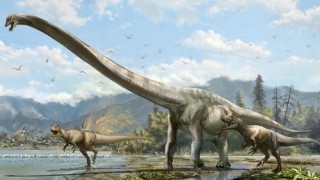
A massive “dragon” dinosaur has been discovered by Chinese farmers in Qijiang city. The remains of the 50-foot dinosaur were discovered while a group of villagers were attempting to fashion a fishing pond in the Chongqing province.
The behemoth dinosaur, which once roamed the Earth during the Late Jurassic around 160 million years ago, was then unearthed by paleontologists from the University of Alberta.
Dubbed the “dragon of Qijiang,” or Qijianglong, the specimen’s long skeleton was first found in 2006. According to researchers from the University of Alberta, the dinosaur was awarded its name because the farmers thought the ancient dinosaur’s bones were similar in appearance to that of the dragons described in Chinese folklore.
“We found the dinosaur’s huge vertebrae with the skull and the tail, but couldn’t find any bones from the hands or the legs. So the locals began to say the long body looked just like a dragon from ancient Chinese stories,” explained University of Alberta researcher Lida Xing.
Qijianglong guokr belongs to a group of dinosaurs called mamenchisaurids, which are members of the sauropod dinosaur genus. The herbivorous dinosaurs are renowned for possessing long necks that make up around half their overall body length. Meanwhile, other sauropods - including brachiosaurs, brontosaurs and the diplodocus - typically have necks that are around one-third of their total body length.
During the excavation process, the researchers found that the creature’s vertebrate was still attached to its head, a discovery that’s very rare in the world of paleontology. The team also established that the dinosaur’s vertebrae would have been filled with air, thereby helping to reduce the weight of the neck. Adding to this, the vertebrae configuration is not too dissimilar to that of a crane, providing up and down movement, but little in the way of lateral flexibility.
In a recent press release, Tetsuto Miyashita, another University of Alberta researcher, said the creature’s astonishingly long neck was a sign that evolution was capable of accomplishing “extraordinary things.” With the mamenchisaurid being exclusive to Asia, and developing in isolation from the rest of the planet, Miyashita argues that something unique must have taken place on the continent.
A Qijiang museum is currently housing the fossilized skeletal remains. However, the authorities are planning to have the fossils transported to a new museum in the city that is currently under construction.
The study, entitled A new sauropod dinosaur from the Late Jurassic of China and the diversity, distribution, and relations of mamenchisaurids, was published in the Jan. 26 issue of the Journal of Vertebrate Paleontology.
